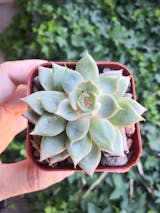About Echeveria Cuspidata 'Tough' Japanese
Echeveria Cuspidata 'Tough' Japanese is a succulent of the Echeveria genus in the Crassulacea family. It is a small succulent variety whose leaves are ovate, leaf tips and margins turn red easily. When it thrives, the leaves are thick, the succulent type is wrapped, and the leaf tip and margin are bright red. If the sunlight is insufficient, or the climate is hot, the plant will be more obviously green, with only a little red edge.
How to care for Echeveria Cuspidata 'Tough' Japanese
Sun: Like most Echeveria succulents, Echeveria Cuspidata 'Tough' Japanese prefer sufficient sunlight. In the growth period, giving it full direct sunlight is better to help it thrive. Please place it under the shade cloth during the hot after in hot summer noon. Click here to learn how to care for succulents in summer.
Temperature: The best growth temperature of Echeveria Cuspidata 'Tough' Japanese is 59~77°F if the high temperature above 95°F in summer begins to show slow growth. When the temperature is lower than 41°F in winter, it will go dormant. Frost damage may occur. So pay attention to temperature control and water control in summer, and it is best to maintain the temperature above 50°F in winter to allow it to winter safely. Click here to learn more about succulent dormant.
Soil: Using the succulent soil mix is the best option. It would help if the particles in the soil were around 30%, which is conducive to young Echeveria Cuspidata 'Tough' Japanese growth. When it grows bigger, it is time to increase the proportion of particles, which is most appropriate, to about 60%-80%. It is helpful for water control if the proportion of particles is high.
Watering: Generally, you don't need to water Echeveria Cuspidata 'Tough' Japanese as frequently as other succulent plants because it stores water in its thick leaves and stems. When you see wrinkles in your succulent's leaves, this could mean your plant is either thirsty or has had too much water. Overwatering and excessive moisture in the soil can result in rotting succulent roots, which can impede the plant's ability to absorb nutrients and cause the leaves to become soft and wrinkled. You should water the succulent thoroughly until the soil is completely dry. Click here to learn how to save overwatered succulent.
Propagation: Look at its thick leaves, which must be suitable for leaf propagation. Gently shake the ripe leaves at the bottom until removed. Place the removed leaves in a dry and ventilated place for a few days until the wound becomes scarred. Lay the leaves flat on the soil and wait for the roots to grow. Click here to learn more about succulent leaf propagation.
More information
Primary color: Green
Secondary color: Red
Cold hardiness: USDA zones 11 (40°F)
Product format: rooted in 2" nursery pot.
Suitability: balcony, window
Propagation: leaf, behead





